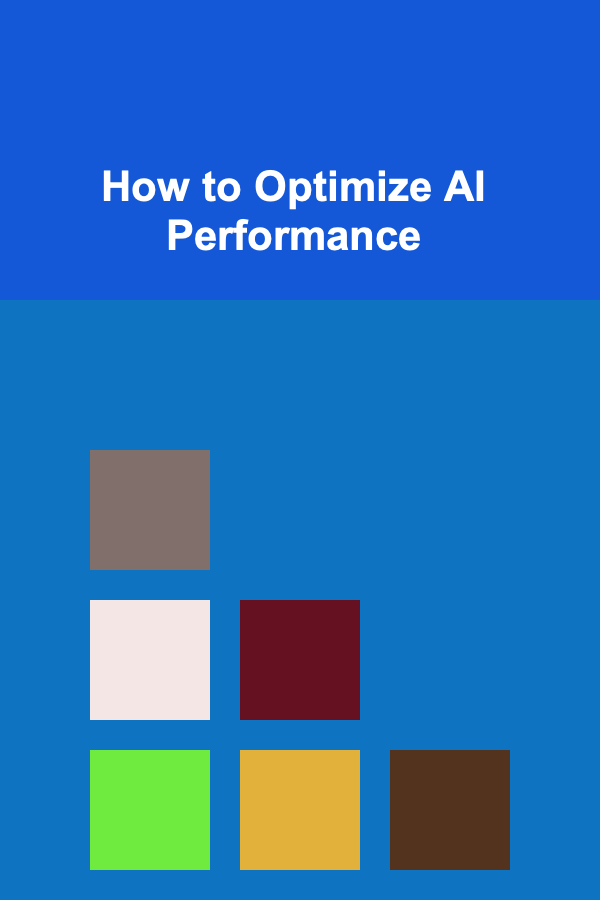
How to Optimize AI Performance
ebook include PDF & Audio bundle (Micro Guide)
$12.99$7.99
Limited Time Offer! Order within the next:

Artificial intelligence (AI) has become a transformative force in many sectors, ranging from healthcare and finance to entertainment and manufacturing. As AI continues to advance, ensuring its optimal performance is crucial for achieving the desired outcomes while maintaining efficiency, scalability, and reliability. This article explores various methods and strategies for optimizing AI performance, including understanding the underlying factors, enhancing model accuracy, accelerating computational processes, and addressing common challenges faced in AI optimization.
Understanding AI Performance
Before diving into optimization techniques, it's important to understand the factors that contribute to AI performance. AI systems, particularly machine learning (ML) models, rely on several elements that collectively determine their success:
- Model Architecture: The structure of the AI model plays a significant role in its performance. Different algorithms and architectures, such as neural networks, decision trees, and support vector machines, have varying capabilities in terms of accuracy, speed, and scalability.
- Data Quality: AI models are only as good as the data they are trained on. High-quality, well-labeled, and representative datasets are critical for producing accurate and reliable results.
- Training Process: The process of training an AI model involves feeding data into the model, adjusting parameters, and optimizing for the best performance. Factors such as the training algorithm, hyperparameters, and optimization techniques affect the model's ability to generalize.
- Computational Resources: The hardware used for training and deploying AI models, such as GPUs and TPUs, can significantly impact the speed and efficiency of AI processes. Inadequate resources may result in slower training times or suboptimal performance.
- Evaluation Metrics: The methods used to assess an AI model's performance are essential for determining how well it meets the required objectives. Common metrics include accuracy, precision, recall, F1 score, and area under the curve (AUC).
Understanding these elements provides the foundation for identifying areas for optimization, allowing for targeted improvements in model accuracy, computational efficiency, and generalization capabilities.
Strategies for Optimizing AI Performance
Optimizing AI performance requires a combination of techniques that focus on enhancing the model, improving computational efficiency, and addressing specific challenges. Below are several strategies to optimize AI performance.
1. Data Optimization
One of the most significant factors influencing AI performance is the quality of the data used for training and evaluation. Optimizing the data pipeline can lead to substantial improvements in model accuracy and efficiency.
Data Cleaning and Preprocessing
AI models rely heavily on clean, high-quality data. Data preprocessing involves several steps, such as removing noise, handling missing values, and normalizing data. These actions ensure that the model receives consistent and relevant information, which helps it learn more effectively.
- Handling Missing Data: Missing values can distort the training process. Techniques like imputation (filling in missing values with mean, median, or mode) or removing records with missing data are commonly used.
- Data Normalization and Scaling: Features in a dataset often vary in scale. Normalizing data (e.g., using Min-Max scaling or Z-score normalization) ensures that no single feature dominates others, allowing the model to learn better patterns.
Feature Engineering
Feature engineering involves selecting, modifying, or creating new features from raw data to improve the model's performance. By identifying the most relevant features, reducing dimensionality, or creating new ones through domain knowledge, models can focus on the key aspects that drive predictions.
- Feature Selection: By using techniques like correlation analysis, backward elimination, or random forests, irrelevant or redundant features can be discarded, improving the model's efficiency and preventing overfitting.
- Dimensionality Reduction: Methods such as Principal Component Analysis (PCA) or t-SNE can be used to reduce the number of features, allowing models to operate more efficiently without sacrificing predictive power.
Data Augmentation
For tasks like image classification, data augmentation techniques (e.g., rotating, flipping, or cropping images) can artificially increase the size of the training dataset, improving the model's ability to generalize. This is particularly useful in domains where data is scarce.
2. Model Optimization
Optimizing the AI model itself is a crucial step in improving performance. This involves adjusting the model architecture, hyperparameters, and training techniques.
Choosing the Right Model Architecture
The architecture of the AI model should be selected based on the specific problem it is solving. For example:
- Convolutional Neural Networks (CNNs) are ideal for image and video analysis due to their ability to capture spatial hierarchies in data.
- Recurrent Neural Networks (RNNs) and Long Short-Term Memory (LSTM) networks excel at sequential data, such as time series or natural language processing tasks.
- Transformer models, such as BERT and GPT, have shown great success in handling complex language tasks due to their attention mechanisms.
By choosing the appropriate architecture, AI models can focus on the relevant patterns in the data, improving both accuracy and efficiency.
Hyperparameter Tuning
Hyperparameters are settings that govern the learning process, such as the learning rate, batch size, and number of layers in a neural network. Tuning hyperparameters can have a substantial effect on AI performance.
- Grid Search and Random Search: These methods involve searching through predefined ranges of hyperparameters to find the optimal configuration. While grid search is exhaustive, it can be time-consuming, while random search is more efficient but less systematic.
- Bayesian Optimization: A more advanced method that uses probabilistic models to find the best set of hyperparameters by balancing exploration and exploitation.
Regularization
To avoid overfitting and improve the model's ability to generalize to unseen data, regularization techniques such as L1 (Lasso), L2 (Ridge), and dropout are commonly used. Regularization helps penalize overly complex models, encouraging simpler ones that can generalize better.
3. Computational Optimization
Computational efficiency is another critical aspect of AI performance. Optimizing how AI models are trained and deployed can result in faster execution times, reduced resource consumption, and lower operational costs.
Parallelization and Distributed Computing
Training large AI models, particularly deep learning models, can be computationally expensive. Using parallelization, such as training the model on multiple GPUs or using distributed computing frameworks like TensorFlow and PyTorch, can significantly reduce training time.
- Data Parallelism: Splitting the data across multiple machines or GPUs allows different parts of the data to be processed simultaneously, speeding up training.
- Model Parallelism: Splitting the model itself into smaller components and running them on different machines can help with very large models that cannot fit into the memory of a single machine.
Hardware Optimization
Leveraging specialized hardware can further optimize AI performance. Graphics Processing Units (GPUs) and Tensor Processing Units (TPUs) are designed to accelerate deep learning tasks by performing parallel computations more efficiently than traditional CPUs.
- GPUs: Highly effective for matrix multiplications and vector operations, which are common in AI tasks.
- TPUs: Custom-built for machine learning tasks, TPUs offer even greater performance than GPUs, especially for large-scale models.
Model Quantization and Pruning
- Model Quantization: This technique reduces the precision of the model's weights and activations, making it faster to run and requiring less memory without significantly impacting accuracy.
- Model Pruning: Pruning involves removing less important weights from the model, reducing its size and improving inference speed without sacrificing performance.
4. AI Algorithm Optimization
Optimizing the algorithms themselves can enhance both the performance and efficiency of AI systems.
Optimized Algorithms
Certain algorithms are more efficient than others for specific types of problems. For instance, Gradient Boosting Machines (GBMs) and XGBoost often outperform simpler algorithms like decision trees on structured data. By selecting and fine-tuning the most suitable algorithm for the problem at hand, AI systems can achieve better results faster.
Transfer Learning
Transfer learning allows a model trained on one task to be adapted for a new, related task. This can save time and computational resources, especially when the new task has limited data. Transfer learning is commonly used in computer vision and natural language processing.
Ensemble Methods
Combining multiple models through techniques like bagging (Bootstrap Aggregating), boosting , or stacking can lead to improved accuracy. These methods aggregate the predictions of several models to produce a more robust and accurate final prediction.
5. Deployment and Monitoring
Once an AI model is trained, optimizing its deployment and continuous monitoring ensures that it operates at peak performance in a production environment.
Model Deployment
Efficient deployment practices, such as model compression (to reduce size), containerization (using Docker or Kubernetes for easy scaling), and edge computing (deploying models on edge devices), can improve AI performance by reducing latency and enhancing scalability.
Continuous Monitoring and Fine-Tuning
AI models can degrade in performance over time as data distributions change. Continuous monitoring is essential to ensure that models continue to perform well. Fine-tuning models with new data, implementing feedback loops, and adjusting hyperparameters periodically help maintain high performance.
Conclusion
Optimizing AI performance is a multi-faceted endeavor that requires careful consideration of several factors, including data quality, model architecture, computational efficiency, and deployment strategies. By implementing data preprocessing techniques, selecting the right model, tuning hyperparameters, and leveraging advanced hardware, organizations can significantly improve the performance of their AI systems. Additionally, continuous monitoring and optimization in production are essential for maintaining long-term success. As AI continues to evolve, the strategies for optimizing its performance will also advance, ensuring that AI remains a powerful tool for solving complex problems across industries.
Reading More From Our Other Websites
- [Home Holiday Decoration 101] How to Choose the Right Holiday Colors for Your Home Decor
- [Hiking with Kids Tip 101] Best Family‑Focused Hiking Apps That Teach Kids About Flora and Fauna in Real Time
- [Home Staging 101] How to Incorporate Outdoor Spaces into Your Home Staging
- [Home Space Saving 101] How to Transform Your Small Room with Murphy Bed Ideas
- [Home Family Activity 101] How to Create an Indoor Obstacle Course for Family Fun
- [Tie-Dyeing Tip 101] 3-D Tie-Dye Effects: Combining Fabric Folding Techniques with Resin Stains
- [Organization Tip 101] How to Incorporate Mindfulness into Your Daily Chores
- [Organization Tip 101] How to Involve Kids in Organizing Their Craft Supplies
- [Organization Tip 101] How to Store Canned Goods Efficiently in Your Pantry
- [Personal Care Tips 101] How to Treat Dry, Damaged Cuticles with Cuticle Oil

How to Advocate for Sustainable Policies
Read More
How to Become a Social Media Manager: A Complete Guide
Read More
How to Track Your Spending Effectively
Read More
How to Program Service Robots for Everyday Tasks
Read More
How to Choose the Perfect Backpack for Style and Function
Read More
How to Edit Food Photography for Instagram
Read MoreOther Products

How to Advocate for Sustainable Policies
Read More
How to Become a Social Media Manager: A Complete Guide
Read More
How to Track Your Spending Effectively
Read More
How to Program Service Robots for Everyday Tasks
Read More
How to Choose the Perfect Backpack for Style and Function
Read More